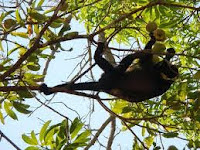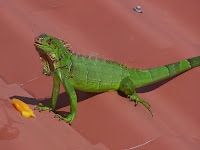 Mango is a sizable oval tropical fruit with a smooth skin that goes from green to red in the color spectrum. The pulp of this delicious fruit is juicy and aromatic, enveloping a large and hairy seed.
Mango is a sizable oval tropical fruit with a smooth skin that goes from green to red in the color spectrum. The pulp of this delicious fruit is juicy and aromatic, enveloping a large and hairy seed. The scientific name of the mango tree is mangifera indica. The mango is native to East Indian subcontinent, from where it has spread all over the world over hundreds of years.
The mango trees were introduced in Costa Rica in early 1800s from travelers coming from other Latin American countries. There are large mango farms in Alajuela and Orotina area; however, mangos are very easy to find along the pacific coast. Almost everybody in Ojochal, Uvita, Dominical, and Manuel Antonio have at least one mango tree, and virtually every vacant lot has one or two. That means there are mangos for everybody in Costa Rica, and enough to export to other countries.
The most popular varieties grown in Costa Rica are:
Ataulfo. It has a small seed, sweet and creamy flavor, and smooth firm flesh with no fibers. Its color is vibrant yellow.
Keitt. It is sweet and fruity, firm juicy flesh with limited fibers, large oval shape. It color is dark to medium green with a pink blush over small areas.
Haden. It has a flavor full of rich and aromatic overtones, firm flesh due to fine to medium fibers, average to large with oval to round shape. Its color is bright red, green, and yellow.
Tommy Atkins. It is mildly and sweet, firm flesh with fibers throughout, medium to large with oval or oblong shape. A dark-red blush often covers much of the fruit with green and yellow-orange accents.
It is worth to mention that Ticos have a very informal and easy way of referring to the mango categories, regardless to the above classification:
Mango Creole, also called by the locals, Manguito Criollo, this is the little mango of Costa Rica (manguito is the word used for small mango.)
Manga, this is the large mango of Costa Rica.
Both kinds are sub-classified as green or ripe.
It is a culinary tradition to eat the mango when is still green; as a refreshing snack, they peel it, slice it and eat it with salt. Yummy!
We have those two kinds in our properties. One of them appears to be the Haden kind; they are delicious, and this year; we harvested several of them with a weight up to 1.5 kg. We started calling them huge-mango-mangos. The other kind we have in the property seems to be what locals call “mango Creole” it is small, yellow, and a little stringy. It is the kind you can roll in your hand to make it super soft, then pierce and suck out their refreshing sweet juice. What an experience!
This link shows varieties of mangos. http://toptropicals.com/html/toptropicals/articles/fruit/varieties_mango.htm
In Costa Rica, mango trees start flowering in January through March, being triggered by the summer time in this region. The mango tree produces thousands of tiny pink-yellow flowers, a large percentage of them self-abort, and the flowers left will mature and produce fruits. The tree produces fruit between February and July; some people say that length of the harvest can go from 90 to 150 days. This year has been particularly abundant in the mango production.
 The commercial mango growers in Costa Rica do not use the mango seed to grow brand new trees. They consider this practice undesirable for the production of quality fruit. Nevertheless, the fertile land in Costa Rica allows new trees to grow from seeds that have been left over the ground, after being stripped from their flesh by a monkey or squirrel.
The commercial mango growers in Costa Rica do not use the mango seed to grow brand new trees. They consider this practice undesirable for the production of quality fruit. Nevertheless, the fertile land in Costa Rica allows new trees to grow from seeds that have been left over the ground, after being stripped from their flesh by a monkey or squirrel. Everyone loves mangos, sometimes; we even have to fight over them.
It is fascinating to find information about mango trees and the mango fruit, for example:
- - The mango tree is sacred in India. It is a symbol of love, and is used at the weddings to ensure the couple will have plenty of children.
- - Some people in India believe that the mango tree can grant wishes.
- - In India, the mango leaves are use to make garlands and runners to be hung at the doorway of the home during Hindu new year, wedding, or birth of a child.
- - Mango wood is used to make furniture, carving, and wood paneling.
- - Burning mango wood, leaves or debris, is not recommended because it toxic fumes could irritate your lungs and eyes.
- - Some people say that mango leaves could be toxic and kill or other grazing livestock. However, some others process the mango pits to use in the cattle feed.
It seems like every part of the mango is beneficial, and they have been utilized in traditional remedies in one form or another. Bark, leaves, skin or pit, have been connected to various types of treatments throughout the centuries.
Here are some of the medicinal properties attributed to the mango tree over the centuries: Anti-viral, Anti-parasitic, Anti-septic, Anti-asthmatic, Expectorant, Cardio tonic, Contraceptive, Aphrodisiac, Hypotensive, Laxative, and Stomachic. Whether a myth, or not, one thing is for sure, when you eat the mango fruit, you feel better.
There has been extensive research about mangos, and they seem to be rich in vitamins, anti-oxidants, and very low in calories. Mangos are rich in iron, vitamin E, vitamin A, vitamin C, contain soluble dietary fiber; they are low in sodium and high in potassium; they also contain good amounts of b-complex vitamins.
- Mangos contain an enzyme similar to the one found in papayas that helps to sooth your stomach acting as a digestive aid, and can actually be held responsible for that feeling of contentment experienced after eating them.
- Mangos are good to replenish lost salts, vitamins, minerals, and energy after you exercise. Reach for a mango instead of an energy drink after you exercise; you will feel better, and it is natural.
Mango Nutrient Information | ||
Serving size: 3 1/2 ounces mango slices | ||
| ||
Mangos are a healthy and delicious way to stay in shape.
Do you remember that all saying about “one apple a day, keeps the doctor away”? Well, we have replaced it for “one mango a day, keeps the doctor away.” Of course, this is the tropical version.
We have been very blessed by having so many mangos in our properties; we have had enough to share with our friend. Besides eating them fresh, we have used them in sauces; we have prepared pudding, smoothies, mango cobbler, and mango pie.
Some people believe that mangos should not be stored in the refrigerator; however, living in a tropical paradise, were temperatures are high, we refrigerate them, and they still taste good. We have also freeze them, and they are awesome. In my opinion, no matter what your preferences are, mangos are always delicious.
Next time you come to Costa Rica, make sure you enjoy this wonderful fruit.
“Mango, the King of the Fruit World”











No comments:
Post a Comment